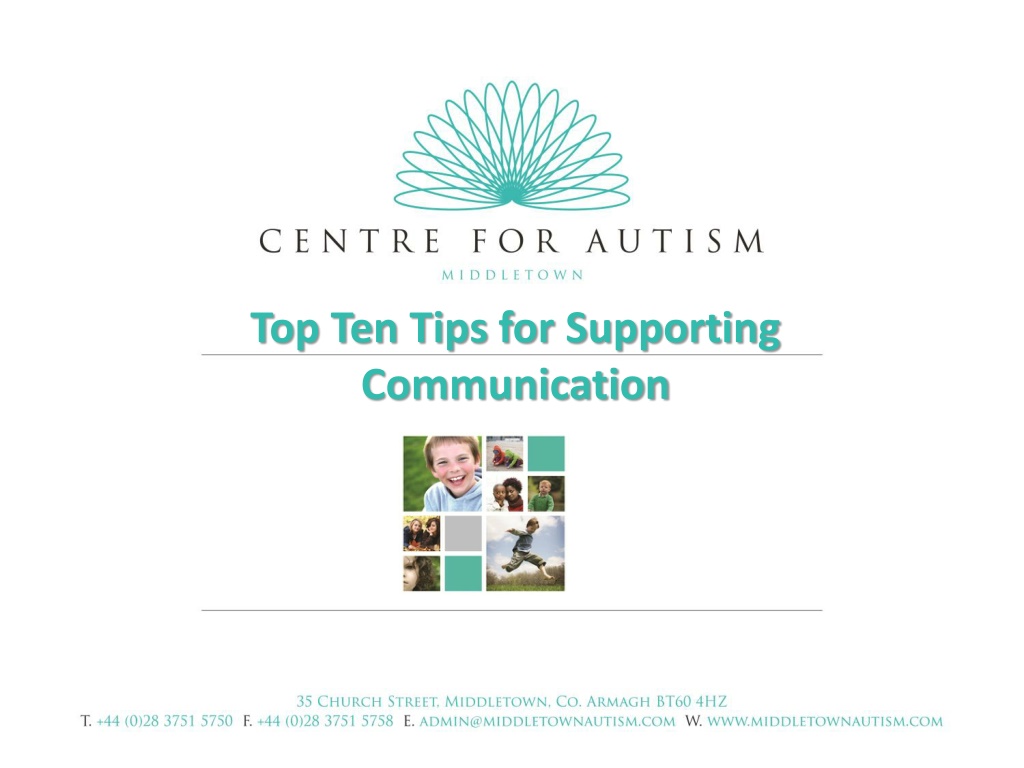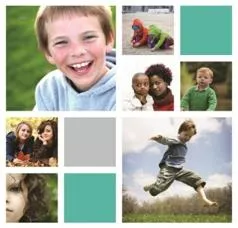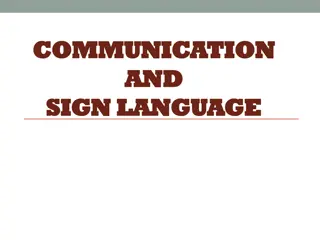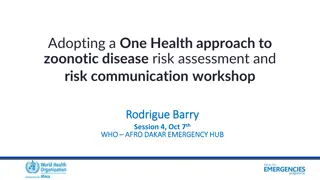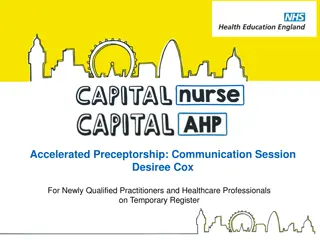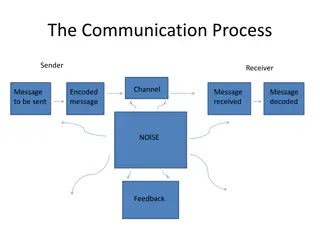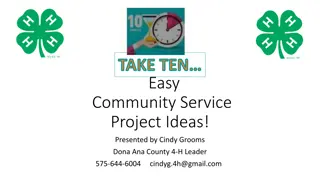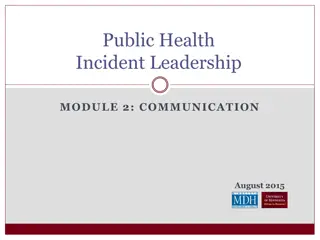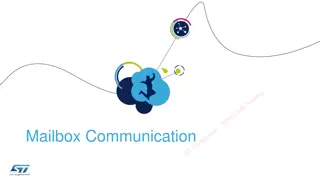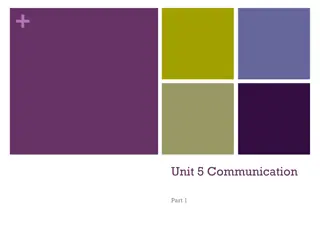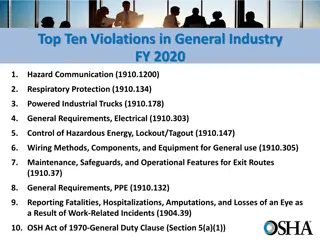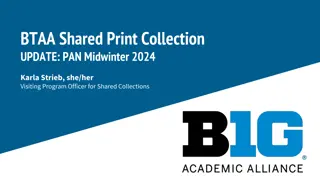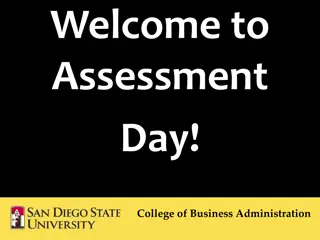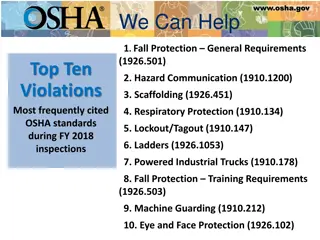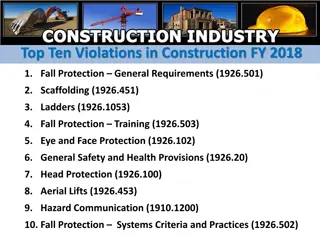Top Ten Tips for Supporting Communication
Children with autism benefit from environmental modifications, establishing attention, and creating opportunities to support communication. Visual strategies and consistent use of visual structures can enhance communication and behavior.
Download Presentation

Please find below an Image/Link to download the presentation.
The content on the website is provided AS IS for your information and personal use only. It may not be sold, licensed, or shared on other websites without obtaining consent from the author.If you encounter any issues during the download, it is possible that the publisher has removed the file from their server.
You are allowed to download the files provided on this website for personal or commercial use, subject to the condition that they are used lawfully. All files are the property of their respective owners.
The content on the website is provided AS IS for your information and personal use only. It may not be sold, licensed, or shared on other websites without obtaining consent from the author.
E N D
Presentation Transcript
Top Ten Tips for Supporting Communication
1. Modify the environment 1. Modify the environment Children with autism are strong visual learners so visual information will be distracting, even if it s not what you want the child to focus on Difficulties with attention mean they can only process ONE piece of information at once make sure it s what you want the child to focus on make you Number One! What can you do? Reduce background noise and distractions where possible e.g. switch off the white board when not in use, cover up busy wall displays, consider where the child or young person is sitting e.g. are they sitting close to a noisy photocopier? Is light reflecting on a white board?
2. Establish Attention 2. Establish Attention Consider how you are engaging the child or young person Are you offering an irresistible invitation to learn? Does what you are doing inspire the child's attention?
You have to become more interesting than You have to become more interesting than whatever else is in the environment whatever else is in the environment Get on the pupil s level Get physically close to the child but know your audience! Get yourself in the child s line of vision Use the child s name at the start of the sentence E.g. Jack, it s time for break Instead of It s time for break, Jack Watch for the pupil to orientate to you Become animated! Use visual strategies
3. Create opportunities 3. Create opportunities Why would a pupil communicate a need or desire if everything is readily available? For example, at breakfast often making sure that the child or young person has everything he/she wants and needs available at the table reduces their opportunity to communicate to e.g. make a request.
4. Support communication visually 4. Support communication visually- -use consistently consistently use
How Can Visual Structures Help With How Can Visual Structures Help With Communication and Behaviour? Communication and Behaviour? Visual information such as objects, pictures, and written language are non-transient. They remain present long enough to provide an opportunity for the child to engage his or her attention before the message disappears.
5. Use gestures and body language 5. Use gestures and body language Non-verbal communication adds meaning to language Facial expressions smiling, frowning, raising eyebrows Hand gestures pointing, using hands to emphasis a point Eye movements looking with appropriate gaze for an appropriate time, eye pointing
Tip to Remember Tip to Remember At least 50% of the message is conveyed through non-verbal communication Children and young people who find listening and understanding language difficult often rely on non-verbal communication to help compensate for their lack of understanding of verbal information.
6. Slow and clear 6. Slow and clear Understanding spoken language depends on: The pupil s listening and attention skills The pupil s motivation and interest The clues a pupil can glean from the situation and the speaker The vocabulary used The amount of information and sentence length The inclusion of non-literal or ambiguous language Remember key words Talk so slowly that it feels funny then you will probably be talking at the right speed
Inadvertently you can make the auditory signal more difficult to understand by:- Repeating Raising your voice Changing the order of the words
7. Wait 7. Wait Be aware that each child or young person will have a different processing time which can change throughout the day Remember the 10 second rule Don t fear silence! If you have to repeat your statement , be aware of changing what you say
8. Try commenting rather than questions 8. Try commenting rather than questions Children and young people with delayed language development often engage quietly in activities. Questions are important to develop a child or young persons understanding but be aware of the quality and quantity of questions. Instead use comments Explain what they are doing Repeat what they say Expand their utterance by adding a few extra words
A note on questions A note on questions Avoid closed questions i.e. involving a yes or no response or allow for giving a one word answer. Use open questions to encourage the use of more than one word E.g. What would you like to choose? What is the man doing? Questions should relate to what the pupil is doing or looking at One question for every 4 comments
9. Respond 9. Respond Respond by modelling language which is useful for the child or young person: Explaining: describe what the pupil is doing or looking at using short simple sentences Repeating: repeat what the pupil says but use a correctly structured and articulated sentence, e.g: Pupil: I catched the ball Pupil: I went on a dain Adult: ah, you went on the train Adult: yes, you caught the ball Expanding: develop what the pupil has communicated by repeating it back and adding something, for example: Pupil: walking Adult: yes, Jack s walking Pupil: (points to car) Adult: car (plus the sign for car)
What about misunderstandings? What about misunderstandings? Don t pretend that you have understood. Its important to give honest and appropriate feedback If you have to interpret the message repeat it back so that you can check the you have understood the intended meaning
10. Stay with the interaction until the goal is 10. Stay with the interaction until the goal is achieved achieved When pupils encounter a communication breakdown the result can be: A behaviour outburst Withdrawal from the communication attempt Inappropriate participation These are all forms of challenging behaviour
10. Stay with the interaction until the goal is 10. Stay with the interaction until the goal is achieved achieved When pupils don t understand, they need to let you know. But frequently, the don t know how to. Encourage them to persist and keep trying if you don t understand This may not be easy to do, but helping the pupil use a variety of strategies, particularly visual strategies, to communicate will help them repair the breakdowns.
Remember! Remember! If a child or young person with autism is upset or angry, he may not understand as well as he would in calmer circumstances might have an even longer processing time than usual Check that he or she has understood by asking him to repeat what has been asked
References References Frost, L. and Bondy, A. (2002) The Picture Exchange Communication System Training Manual Pyramid Educational Consultants, Newark Hodgdon, L. (1999) Solving Behaviour Problems in Autism: Improving Communication with Visual Strategies Quirk Roberts Publishing, Michigan McLachlan, H., Elks, L., Brunton, C. and Fisher, C. (2013) Language Builders for Pupils with SLD: Advice and activities to support pupils with communication needs and severe learning difficulties Elkan, Cornwall
